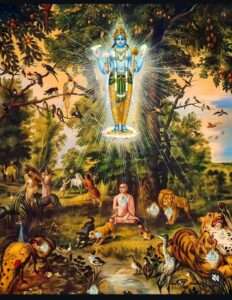 Krishna’s inner self is Consciousness itself and, in certain Sruti texts, is defined as Brahman.
Krishna’s inner self is Consciousness itself and, in certain Sruti texts, is defined as Brahman.
The Sruti texts alluded to by Sri Jiva are some verses of the Upanisads, in which Krishna is defined as satyam jnanam anantam brahma, “Brahman is truth, knowledge and infinity”; then astityavopa-labdhavyah, “He should be realized as the One who exists.” When it is said that “the Supreme is pure consciousness”, “truth”, “knowledge”, etc., it is intended to describe His qualities or energies. Therefore, in this first part of section eight, Sri Jiva gives a quick description of the energetic and impersonal aspect of the Lord.
Both Gosvami Maharaja and Baladeva Vidyabhusana point out that when Krishna is described in his Brahman aspect, the word ananda never appears. In fact, ananda, supreme happiness, that which can deeply satisfy the heart of the living being, can only be achieved in the development of a loving relationship with the Person of Godhead, Bhagavan.
A portion of Brahman manifests as its own partial incarnation, ruling Maya in her Purusa aspect and in her main form, being called Narayana, the one who plays in Paravyoma.
With these words, Jiva Gosvami concludes the description of the three aspects of the Absolute Truth, in which Krsna manifests Himself eternally. Here Sri Jiva evidently refers to verse 1.2.11 of the Bhagavata Purana, which says:
vadanti tat tattva-vidas
tattvam yaj jnanam advayam
brahmeti paramatmeti
bhagavan iti sabdyate
“Those who are in possession of perfect knowledge and who know the Absolute Truth call this nondual substance Brahman, Paramatma and Bhagavan… Brahman is His impersonal or energetic aspect, Paramatma is His aspect located in this world and Bhagavan is the Supreme and Ultimate aspect.”
The word advayam deserves attention.
In the commentary on the above verse, Srila Prabhupada says that “the Absolute Truth is both subject and object and therefore presents no qualitative difference. Therefore Brahman, Paramatma and Bhagavan are qualitatively the same. The same substance is realized as Brahman, Paramatma and Bhagavan.”
A few lines below, Prabhupada uses the sun as an example and says:
“Unintelligent students from various schools sometimes argue in favor of their respective realizations, but those who are perfect seers of the Absolute Truth know that the three aspects of the Truth are different perspectives, that is, different angles of vision.”
Thus, the impersonal aspect, realized by the impersonalistic jnanis through the process of cultivation of transcendental knowledge, is real, as is the Paramatma in the heart, achieved by the yogis after asceticism and meditations. And supremely real is also the Supreme Personality of Godhead of the devotees of bhakta. Of all these aspects, Bhagavan is the supreme and is the origin of the others, as is very clear from the following verses of Srimad-Bhagavatam, including the phrase ‘samsiddhir hari-tosanam’ (1.2.13).
The second aspect of Krishna, Paramatma, is the origin of the various avataras, technically known as vibhava (or vaibhava). These are the same as Bhagavan, but possess a lesser degree of powers. Paramatma, which is none other than one of the Purusavatara, i.e. Visnu, is the origin of Lilavatara and Gunavatara.
This is a section of the book “Tattva Sandarbha”, in English.
To buy the complete book, click here



Leave a Reply